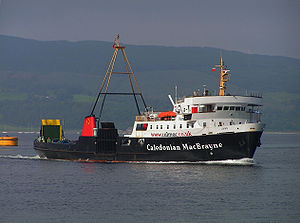MV Juno
 MV Juno leaving Rothesay (2007) | |
| Career (UK) | |
|---|---|
| Name: | MV Juno |
| Operator: | Caledonian MacBrayne |
| Port of registry: | Glasgow |
| Route: | Rothesay-Wemyss Bay (summer); Upper Clyde (winter) |
| Builder: | James Lamont & Co, Port Glasgow |
| Cost: | £820,000[1] |
| Launched: | 16 September 1974 |
| Maiden voyage: | 2 December 1974 |
| Identification: | IMO number: 7341063 |
| Status: | No longer in service |
| General characteristics | |
| Tonnage: | 854 GRT; 209 tons deadweight (DWT) |
| Length: | 66.45 metres (218 ft) |
| Beam: | 13.8 metres (45 ft) |
| Draft: | 2.41 metres (8 ft) |
| Depth: | 4 metres (13 ft) |
| Installed power: | 2 x 4SCSA 8 cylinder diesel engines, 1000 bhp each[2] |
| Propulsion: | 2 Voith Schneider Propellers, one at each end of the hull, on the centreline |
| Speed: | approximately 12 knots |
| Capacity: | 531 passengers, 38 cars[3] |
| Crew: | 10 |
MV Juno is a vessel that served Caledonian MacBrayne since 1974, and was the second of two sister ships, her older sister being MV Jupiter. The Juno left service in late 2006 as she finished her last assignment on the Rothesay to Wemyss Bay route.[3]
History
MV Juno took to the water at Lamount's in Port Glasgow, on 16 September 1974 and was christened by Mrs W M Little, wife of the Managing Director of the Scottish Transport Group, Calmac's owning company at the time. She was remarkably similar to MV Jupiter, although her internal decoration was brighter, the ticket office faced aft rather than stern, and she had a curved flying bridge (although the Jupiter soon incorporated such a bridge). This allowed the skipper a clearer view when berthing. The Juno and the Jupiter were remarkably manouverable, being the first in the Calmac fleet to be fitted with Voith Schneider Propellers, which allowed the ships to literally turn within their own mass. This was revolutionary in large vessels as they could berth and depart far quicker than many of the smaller vessels at the time. They would later become affectionately known as 'The three streakers' after the arrival of MV Saturn in 1977.
MV Juno spent much of her first decade in service on the Gourock-Dunoon run, replacing the much smaller Maid of Cumbrae.[1][4] In 1981 the then Secretary of State for Scotland offered the rival firm on the Hunter's Quay-Mclnroy's Point route, Western Ferries, a grant to buy an additional vessel to provide a frequent, high speed passenger only service from Gourock to Dunoon. At this point, Calmac were considering the termination of their route. This was disallowed, as this decision would cause an outrage among the residents of Dunoon and Gourock. This meant that Calmac must find a vessel which would offer a passenger only service on the route, but financially this was not an option. Calmac instead decided to resume service with the Juno, but with only one sailing per hour. This allowed popularity to grow with the private firm, Western Ferries, which would have been vulnerable to being put out of business by the frequent Calmac service.[1][4]
The Recent Years
From 1986, the "streakers", MV Jupiter, MV Saturn and Juno provided three rosters on the Upper Clyde: one each at Dunoon and Rothesay and the third (1A Roster) to Kilcreggan with peak sailings to Dunoon and Rothesay.[3] Initially they interchanged roster each month, but this became weekly in 1996. With the introduction of MV Pioneer on the Clyde in summers, one of the "streakers" was freed up to carry out a series of cruises on weekday afternoons.[2] From 1993, a trip ran to Tighnabruaich twice a week, after the commuter runs. The cruises were popular and the programme was extended to include Loch Long, the Kyles of Bute, with Tarbert, Loch Fyne on Sundays.[3] The cruises were withdrawn in 2001, leaving two of the "streakers" serving Rothesay, and the other, Dunoon.
In late 2005, MV Bute was introduced on the Rothesay to Wemyss Bay route. Juno partnered her there, until the second new Rothesay ferry, MV Argyle arrived, in early 2007. Juno was displaced and her service was terminated later that year, while her older sister continues to provide a reliable service between Gourock and Dunoon.[3]
Accommodation
The Juno consists of two internal passenger decks, as well as an open deck, built up on the front of the vessel. This allows the foot passengers to remain separate from the car deck which is level with the lower passenger deck. The upper passenger deck consists of a small coffee cabin and games machines, with stairs leading down two the lower deck, consisting of a ticket office (which remained closed after new regulations in 2005), and toilets aft, with doorways leading to the car deck. The Juno had her accommodation renovated in 1993, and lifeboats were replaced by smaller life rafts the following year, to allow for more deck space.[4]
| MV Juno
]]Footnotes
- ↑ 1.0 1.1 1.2 McCrorie, Ian (1980). Ships of the Fleet -- Caledonian MacBrayne. Caledonian MacBrayne. ISBN 0-9507166-0-X.
- ↑ 2.0 2.1 "Juno". Ships of CalMac. http://www.shipsofcalmac.net/profile_juno.asp. Retrieved 6 April 2008.
- ↑ 3.0 3.1 3.2 3.3 3.4 McCrorie, Ian (2006). Calmac Ferries -- Caledonian MacBrayne. Caledonian MacBrayne. ISBN 0-9507166-7-7. Cite error: Invalid
<ref>tag; name "C" defined multiple times with different content - ↑ 4.0 4.1 4.2 McCrorie, Ian (1985). Hebridean and Clyde Ferries of Caledonian MacBrayne. Caledonian MacBrayne.

